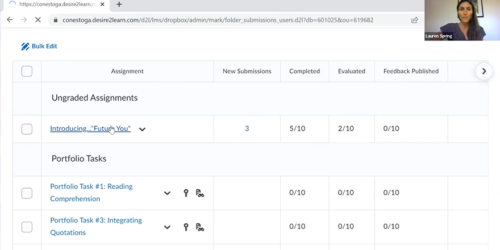Updating Rubrics to Prevent Grade Inflation
Grade inflation is a well-known phenomenon.
Check out some thoughts and data from Harvard in Grade Inflation: What Goes Up Must Come Down.
We must ensure that students receive grades that discriminate, in the best sense of the word, the degree to which they have attained the course outcomes. In a general sense, the course learning outcomes measure the knowledge, skills, and attitudes that the student has attained by a certain point in the course or cumulatively at the end of a course.
Using the Grading Procedure to ensure rigour and consistency
Conestoga’s Grading Procedure is designed to remind us as we mark of what the alpha categories mean. You may tend be too generous with a perfect score or a mark in the A category (80% to 100%). This range is reserved for students who have achieved outstanding abilities with the course learning outcomes, NOT those who have followed all the assignment instructions.
The assignment and rubric may need to be revised if this is a concern.
Rubrics play an important part
Grade creep or inflation may also be a rubric problem.
It can be caused by a four-point rubric that does not include a 0 rating or range (i.e., 0-55%) below the pass section. This section is imperative because some students:
- submit nothing related to particular criteria.
- submit materials that do not provide evidence of learning for the associated course outcomes.
- did not address the requirements for some criteria in a meaningful way.
- submitted material that can’t be interpreted due to the writing.
Here are some quick tips for grading and alignment with the alpha categories in the Grading Procedure:
- Your rubric should ideally have at least five levels. The fifth level or the A category is the highest. If you have a rubric with fewer categories, you may need to manually assign part marks as you grade. It is problematic to assign full marks in a category for which there is a range unless full marks are deserved. Work to get the rubric revised for next semester.
- When you’re examining student work for rubric criteria, if the student has simply done everything that was required and not shown any outstanding synthesis or application with associated course learning outcomes then this is likely in the B category, not the highest level and definitely not full marks at that level.
- If the student has submitted nothing for a criteria or provides no evidence of attainment of course outcomes or does not fulfill the set requirements, give a mark below the pass mark for the course. This may require a manual override to zero in the eConestoga rubric.
- A D, which is a pass or approximately 2.7 out of 5 on a 5-point scale, indicates that the student has met the requirements and the outcomes to minimal degree.
Consider the messaging students get from marks. Encourage success without misleading students as to their attainment.
Working together we can ensure that interim marks and final grades continue to have meaning.



